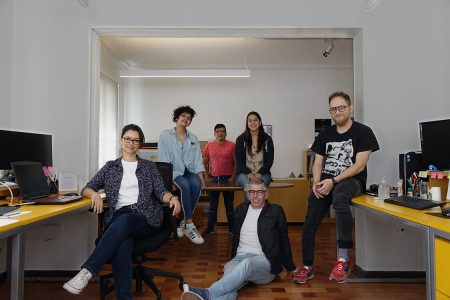When we think of light, the first images that come to mind are those related to our daily life, such as a sunset, the flame of a candle or a lamp. We also relate light to elements such as life, spirituality, etc.

“Light here symbolizes life, and it is foremost among all other determinations. Light comes first; light allows us to see the world. Its essential nature makes light a central concern for all civilizations.” Audrey Azoulay (Director-General of UNESCO) message wrote by him for the Light International Day 2019
If we go deeper, the images and meanings of light multiply and give the impression that light is present in infinite situations in our daily lives, for example scanning a bar code of any product at the store, having a medical examination, an MRI or an X-ray. It is also present when we observe a work of art or when we visit an architectural site.
Light is on the screen of our telephones and televisions, in communication technology, in the microwave oven in our kitchens. All of these situations seem so simple and so obvious that we are practically unaware of their presence.
To better understand the role of light in our lives it is important to understand its origin:
In physics, light is part of electromagnetic radiation that can be perceived by the human eye in the visible spectrum and, like all electromagnetic radiation, it is made up of particles called photons.
A photon is the carrier particle for all forms of electromagnetic radiation, including gamma rays, X-rays, ultraviolet light, visible light, infrared light, microwaves, and radio waves.
“Light is a natural phenomenon which science has come to understand and learned to use, and it plays an essential role in all the sciences and their applications. From the birth of the universe to the creation of all kinds of new technologies, from X-rays to radio waves, in fields as diverse as medicine, agriculture, energy, optics, and countless others, light has shaped – and continues to shape – our world. By understanding light, we are able to achieve the greatest of scientific and technological progress.”
Audrey Azoulay (Director-General of UNESCO) message wrote by him for the Light International Day 2019
It is because of the importance that light plays in our lives that the year 2015 was proclaimed the International Year of Light by the United Nations General Assembly. This activity was coordinated by UNESCO through its International Fundamental Sciences Program with the aim of raising awareness about how light-based technologies can provide solutions to global challenges in energy, education, agriculture and health.
The International Year of Light featured around 13,000 activities in 147 countries with an audience of more than 100 million people. These events promoted a better understanding of the role of light in the modern world and celebrated remarkable discoveries, from the first studies of optics 1000 years ago to the discoveries in optical communication that power the internet today.
Because of the great response from the International Year of Light worldwide, Unesco proposed proclaiming an International Day of Light as an annual activity in which the essential role that light plays in the lives of the world’s citizens in the fields of science, culture, art, education, sustainable development as well as medicine, communication and energy.
Why was May 16th chosen as the International Day of Light?
This day marks the anniversary of the first successful laser operation in 1960 by physicist and engineer Theodore Maiman. The laser is a perfect example of how a scientific discovery can generate revolutionary benefits for society in communications, healthcare, and many other fields.
The International Day of Light has the following main objectives:
- Improve the public understanding of how light and light-based technologies touch the daily lives of everybody, and are central to the future development of the global society.
- Build worldwide educational capacity through activities targeted on science for young people, addressing issues of gender balance, and focusing especially on developing countries and emerging economies.
- Highlight and explain the intimate link between light and art and culture, enhancing the role of optical technology to preserve cultural heritage.
- Enhance international cooperation by acting as a central information resource for activities coordinated by learned societies, NGOs, government agencies, educational establishments, industry, and other partners.
- Emphasize the importance of basic research in the fundamental science of light, the need for investment in light-based technology to develop new applications, and the global necessity to promote careers in science and engineering in these fields.
- Promote the importance of lighting technology and the need for access to light and energy infrastructure in sustainable development, and for improving quality of life in the developing world.
- Raise awareness that technologies and design can play an important role in the achievement of greater energy efficiency, in particular by limiting energy waste, and in the reduction of light pollution, which is key to the preservation of dark skies.
There are many parties involved with initiatives to achieve these goals; UNESCO’s Steering Committee includes representatives from a wide range of international partners related to physics, optics, photonics and lighting. This committee is sponsored by universities, institutes and associations, such as the International Association of Lighting Designers (IALD).
I believe that as lighting designers, we have the responsibility to collaborate in the achievement of these goals from our daily work through responsible designs and the sharing of relevant information in our communities.
Many wonder if lighting design is a science or an art. Victor Palacio’s definition of our profession seems very fair:
“It is a unique combination of science and art used to structure the way that a problem is approached in order to develop a solution. As a discipline of design, the use of light requires understanding a variety of scientific principles that will provide the framework for developing technique. At the same time, it is necessary to develop an aesthetic sensitivity that integrates a correct understanding of the subjective impact of the use of light. The integration of both perspectives allows the development of a balanced and consistent design process.” Excerpt (translated) from an interview in Lightecture magazine with Victor Palacio, former president of the IALD 05/04/2018

Our responsibility as lighting professionals is to define the use of light in the fields of art and culture, architecture and heritage, landscaping and urban planning, and contribute to a better perception of the environment and to improve interpersonal relationships, as well as carries the responsibility of being active participants in the preservation of the environment and dark skies.
I believe we also have the responsibility to participate in the sharing of knowledge about the importance of light as a relevant element in any project and across all human activities.
The participation of lighting designers in foundations, associations, seminaries, talks, is essential to continue creating awareness about the role of light in our lives.
This year, the International Day of Life has as its motto “trust science”, a global campaign to promote the scientific process and recognize the benefits of the science for society.
Due to the SARS COV2 pandemic, the importance of scientific research and public and government trust in scientific processes is very apparent.
Let’s not forget how much we depend on dedicated professionals to find evidence-based solutions to global challenges such as health and the environment.
Referencies:
Noticias ONU: “En 2015, la UNESCO inaugurará el Año Internacional de la Luz.”
Servicio de Prensa UNESCO: “Año Internacional de la Luz – La UNESCO celebra a Alhacén, padre de la óptica moderna.”
International Day of Light UNESCO
Revista Lightecture: “Victor Palacio celebra el Día Internacional de la Luz.”



